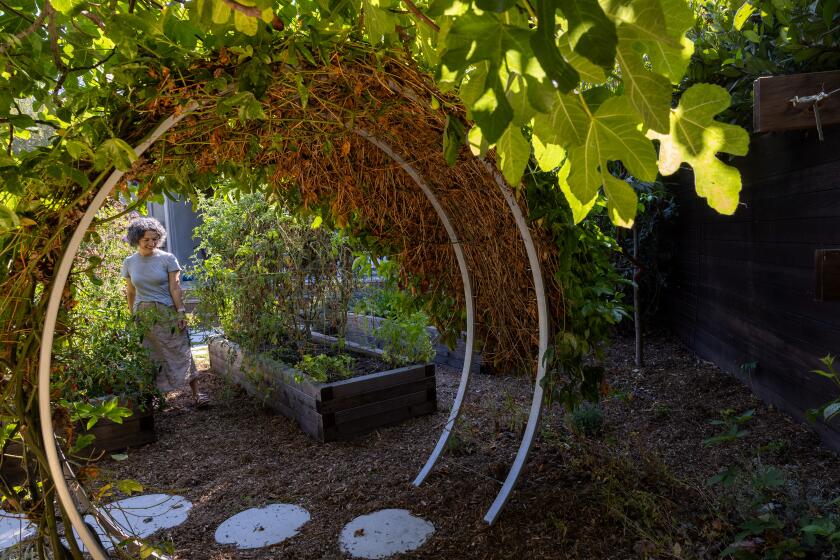GARDENING : Mother’s Day Blooms With Roses
The toughest day Jack Porter ever had was the Saturday he and his wife volunteered to take care of Pixie Treasures, a miniature rose nursery in Yorba Linda.
“I’ve never worked so hard in my life,” said Porter, a neighbor and longtime friend of the owners, Dorothy Cralle and her daughter Laurie Chaffin. “I don’t see how Dorothy and Laurie do it.”
Neither do they.
Surveying the results of their labor--row upon row of tables covered with 30,000 potted miniature roses, all of which they propagated from cuttings and nurtured to sales size--Chaffin conceded that they do have a physically demanding job.
“Yes, we do it all ourselves,” she said, breaking into a hearty, the joke’s-on-us laugh, “and it can’t be done. But we can’t keep help. A couple of days under the hot sun and they’re gone. No one wants to work this hard.”
So why do they?
Cralle, who started the business 22 years ago, summarizes their incentive in one phrase: The need to discover “what can be.”
Chaffin and Cralle are not just growers; they’re hybridizers.
In addition to growing the roses of other hybridizers which they have first test-grown in their garden for suitability to this area, they are adding their own cultivars to the rapidly expanding market of miniature roses.
Every year they make at least 1,000 crosses--manually taking pollen from the stamens of one rose and applying it to the pistils of a second to create a third. Theirs is the quest for the perfect rose--the one with healthy, pest-resistant foliage, superb form, gorgeous color, frequent flowering habit and intoxicating rose scent--all wrapped up in one exquisite package.
Pixie Treasures may not have come up with the ideal miniature rose yet (Cralle, at 75, philosophically said that’s an impossible dream), but with ‘Real Charmer’ and ‘Chipmunk,’ the two new roses they introduced to the market this year, the hybridizers think they’ve come close.
‘Real Charmer’ is a pale pink rose of classic tea shape that blooms profusely on vigorous, healthy foliage. Larger than most miniatures but smaller than a floribunda, ‘Real Charmer’ fits into a mid-size category that the American Rose Society hasn’t named yet. The European market and Jackson and Perkins, the well-known Medford, Ore., rose hybridizers, call them “patio roses.”
Call it what you like, Chaffin said, it’s the perfect size rose for modern condominium gardens. If you love the constant blush of pink roses in your yard, this is the rose for you, she said: “ ‘Real Charmer’ is a workhorse. It blooms and blooms and blooms.”
‘Chipmunk’ is more of a novelty rose. “Peanut butter-colored in the bud stage opening to grape jelly,” is how Chaffin described it. Porter, however, a rosarian who has also been test growing ‘Chipmunk’ in his yard, thinks the color is closer to raspberry jam.
Pixie Treasures usually finds only two or three new roses worth propagating per season out of approximately 1,000 crosses. That may not seem like a successful ratio, but compared to Jackson & Perkins, Chaffin’s batting average is phenomenal.
(Though she seeks input from her mother about which parent plants to cross, Chaffin--with 10 years hybridization experience--does all the nursery’s actual hybridizing). Jackson and Perkins claim to grow, examine, and discard 100,000 hybrid seedlings for every one they introduce to the public.
The exciting thing about miniature roses, Chaffin said, is that you don’t need a country estate to be a successful hybridizer. Pixie Treasures occupies only 1 1/3 acres, not all of which is in production.
“If you have less space, and you’re it as far as manpower goes, you have to be more selective,” Chaffin said. “But anyone with an average back yard can grow enough varieties to experiment with hybridizing miniatures.”
Most miniature rose hybridizers in the business started as or still are back-yard operations, Porter said.
The more experience you gain, the more fun you have with hybridizing, Chaffin said.
“When I’m considering crosses, now I know not only how the potential parent plants have performed over a number of seasons, but how the grandparents performed, too. I’ve seen what happened when I crossed them with other plants, so I can make a better guess about the results.”
A guess it still is, though, she said.
“Rose hybridizing will always be chancier than horse breeding,” Chaffin said with a grin. “There are lots of surprises.”
Another nice aspect about hybridizing, she said, is that, like being a parent, you don’t know what you’ve produced until it’s aged enough to show some character.
“I knew ‘Savannah Miss’ (a pale apricot, classic tea rose with the bonus of fragrance) was going to be a good rose right from the start,” she said, “but I didn’t know how good. It just keeps getting better.”
Porter feels the same about ‘Starla,’ a creamy white miniature that Pixie Treasures introduced several seasons ago.
“If there’s a nicer white on the market, I haven’t seen it,” he said.
Cralle is looking forward to several more decades of seeing seedlings reach fruition. “It’s a phenomenon of this business--maybe because we work in such beautiful settings--but nurserymen live long, long, long lives,” she said. “I hope to, too.”
Chaffin and her mother have Canadian and English stock they’ve imported to experiment with. “Their hybridizers are mainly concerned with creating masses of color, and, since miniatures are used more for landscaping than cut flowers, that’s what we want, too,” Chaffin said.
And there are David Austins to play with. “His roses almost all smell good, so maybe we can get more fragrance into miniatures that way.”
Finding a cross that bears the perfect rose remains her dream. Chaffin may never reach it, but she and her mother will continue working hard trying.






